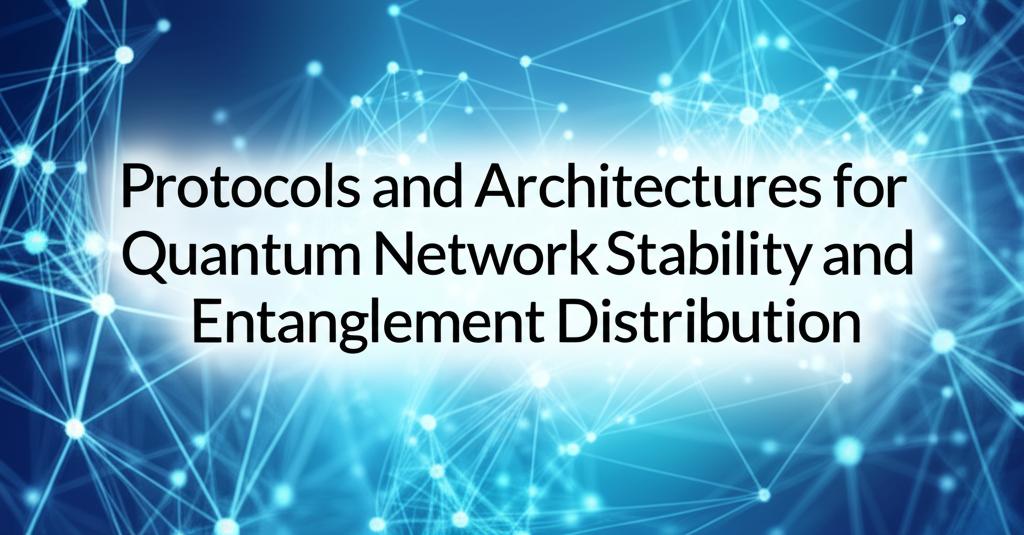Quantum networks promise revolutionary capabilities, from fundamentally secure communication to distributed quantum computing. Central to realizing this potential is the ability to reliably generate and distribute quantum entanglement across the network, while maintaining the fragile quantum states involved. This necessitates sophisticated protocols and robust network architectures designed specifically for stability and efficient entanglement sharing.
Foundations: Distributing EntanglementEntanglement, the unique quantum correlation between particles, serves as a fundamental resource. Distributing entangled pairs (like Bell states) between distant nodes allows for applications such as Quantum Key Distribution (QKD) for secure encryption keys and quantum teleportation for transferring quantum information.
The simplest method, direct transmission of entangled photons through optical fibers or free space, suffers significantly from signal loss and decoherence over distance. To overcome this, entanglement swapping is employed. This technique uses intermediate quantum repeater nodes to connect shorter, independently established entangled links, effectively extending entanglement across nodes that never directly interacted. This is the cornerstone of building scalable quantum networks and repeater chains.
Protocols for Enhancing Distribution and StabilityBeyond basic swapping, several protocols are crucial for practical quantum networks:
- Entanglement Purification/Distillation: Real-world entanglement generation is imperfect, resulting in noisy entangled states. Purification protocols consume multiple low-fidelity entangled pairs to probabilistically produce a single pair with higher fidelity, crucial for reliable applications.
- Quantum Error Correction (QEC): Just like classical networks correct bit flips, quantum networks need QEC to protect qubits from environmental noise and operational errors. QEC protocols encode quantum information across multiple physical qubits to detect and correct errors, preserving the integrity of the quantum state during transmission and storage. Developing robust QEC tailored to network noise is vital for stability.
- Asynchronous Protocols: As networks scale, relying on perfect global synchronization becomes impractical due to communication latencies and complexity. Asynchronous protocols allow repeater nodes to operate more independently, establishing and swapping entanglement links based on local availability and signaling, improving efficiency and adaptability in large networks. Methods like sequential establishment or forward-backward propagation help manage resources without strict timing.
- Network Coding Protocols: Techniques like Measurement-Based Quantum Network Coding (MQNC) aim to improve resource utilization, especially in scenarios with network congestion or competing demands for entanglement, potentially distributing multiple entangled pairs more efficiently than basic swapping.
- Reliable Distribution Protocols: Advanced protocols like REDP (Reliable Entanglement Distribution Protocol) are being designed specifically for large-scale networks, employing strategies to manage resource allocation (like entanglement pairs and sending windows) fairly and efficiently across multiple user requests in a decentralized manner.
The physical layout and components of the network are equally critical for stability:
- Quantum Repeaters: These are essential intermediate nodes. Beyond simple entanglement swapping, future generations will incorporate quantum memories to store qubits and advanced error correction capabilities, evolving from loss-correcting repeaters to fully fault-tolerant ones. They are key to achieving end-to-end entanglement without relying on potentially insecure "trusted" nodes.
- Hybrid Architectures: Near-term and future networks will likely be hybrid:
Ground and Space: Combining terrestrial fiber networks for regional connections with satellite links for long-haul, intercontinental entanglement distribution.
Quantum and Classical Integration: Quantum channels will operate alongside classical control channels, requiring careful integration at the physical, control, and management layers.
Diverse Qubit Technologies:* Networks may need to connect different types of quantum processors (superconducting, photonic, trapped ions, etc.). This drives the need for quantum transducers capable of converting quantum information between different physical encodings (e.g., microwave-to-optical).
- Hardware Advancements: There is a trend towards more practical hardware, including compact, rack-mountable quantum network devices with smaller power and space footprints, easing integration into existing facilities. Advances in entangled photon sources, high-efficiency detectors, and quantum memories are also crucial.
- Network Management and Control: Sophisticated software is needed to manage resources, route entanglement requests, and execute protocols. Network Operating Systems like QNodesOS are emerging to simplify programming and execution of quantum network applications across diverse hardware platforms. Layered protocol stacks (similar to the classical internet model) are being defined to structure network functions.
Several inherent challenges must be continuously addressed:
- Decoherence and Photon Loss: The primary obstacles. Solutions involve minimizing transmission distances between repeater nodes, utilizing quantum error correction and entanglement purification, and developing high-quality quantum memories to hold states reliably.
- Environmental Noise: Physical disturbances like temperature fluctuations, vibrations, or stress on optical fibers can degrade the quantum signal, particularly affecting properties like photon polarization. Active stabilization techniques, such as Automatic Polarization Compensation (APC) using real-time feedback and reference signals, are being successfully demonstrated to counteract these effects on operational networks. Additionally, shielding hardware from electromagnetic interference and vibration is crucial.
- Scalability and Efficiency: Managing entanglement requests, avoiding conflicts during swapping, and routing efficiently in large networks requires intelligent, often decentralized protocols (like asynchronous approaches and REDP) and robust network architectures.
- Security: While entanglement offers inherent security benefits (e.g., detecting eavesdropping), protocols must also guard against malicious nodes or attacks. This involves verifying entanglement quality and potentially using techniques like quantum state encoding to secure distribution. The ultimate goal is networks secured by physics using untrusted quantum repeaters.
The development of stable, large-scale quantum networks is an ongoing process. We are moving from small experimental setups towards more complex, multi-node networks. Progress involves incremental improvements: increasing the number of connected nodes, extending repeater distances, boosting entanglement distribution rates through multiplexing and better hardware, and integrating terrestrial and satellite links. Concurrently, simulation capabilities are advancing, allowing for better design and optimization of network architectures and protocols. Ultimately, the vision is a global Quantum Internet built upon reliable, error-corrected entanglement distribution, seamlessly connecting quantum computers, sensors, and communication devices worldwide. This requires continued innovation across protocols, hardware, control software, and architectural design.

